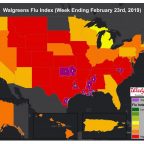Indigenous South Americans With Healthiest Arteries of Any Population Ever Studied Offer Healthy Lifestyle Clues
The Tsimane people—a forager-horticulturalist population of the Bolivian Amazon—have the lowest reported levels of vascular aging for any population, with coronary atherosclerosis (hardening of the arteries) being five times less common than in the U.S., according to a study published today in The Lancet and presented at the American College of Cardiology.
Senior author of the study is Gregory S. Thomas, M.D., MPH, Medical Director, MemorialCare Heart & Vascular Institute, Long Beach (CA) Memorial Medical Center and Miller Children’s & Women’s Hospital Long Beach, part of MemorialCare Health System, which also includes Orange Coast Memorial in Fountain Valley, Saddleback Memorial in Laguna Hills and Community Hospital Long Beach. In addition to the Bolivian study, Dr. Thomas is principal investigator of the HORUS research team studying CT scans of mummies in ancient Egypt and globally. The team found that since atherosclerosis was common in arteries of humans who lived thousands of years ago, it was not just a product of modern lifestyle.
Three years ago, the primarily physician HORUS team joined with the Tsimane Health & History Project anthropology team to evaluate the degree of atherosclerosis in a population living an ancient lifestyle.
Based on their mummy work, Dr. Thomas and his colleagues believed atherosclerosis was inherent to aging. Over time, they expected humans to develop atherosclerosis, including atherosclerosis of the coronary arteries that supply the heart. As blockages appear in these arteries, heart attack and death from heart disease can occur.
The Tsimane (pronounced chee-MAH-nay) indigenous population living along an Amazon tributary in the wilds of Bolivia provided a prime example. If a population could live an ancient lifestyle, growing or hunting their own food for their families, and be active much of the day, researchers hypothesized that they might not develop blockages of their heart arteries, a condition that plagues much of industrialized society.
Following extensive blood tests, a representative sample of 705 Tsimane adults traveled for several days out of the rain forest to undergo non-contrast CT scanning to look for coronary blockages. As blockages mature, calcium deposits seen on a CT scan can be added up to determine an individual’s calcium score. For a U.S. middle aged man, the chance of having calcium in his heart arteries is approximately equal to his age. U.S. women trail 10 years behind. Remarkably, 85% (596 of 705 people) of Tsimane adults had no calcium, demonstrating almost no risk of heart attack. Of the remainder, 13% (89) had a mild degree of calcium with a score of 1-100. Only 3% (20) had a severe degree of calcium, a score over 400. This represents one-tenth the amount of calcium seen in the arteries of U.S. men and women.
In the U.S. calcium accumulation accelerates exponentially with age. In contrast, nearly two-thirds (65%, 31 of 48) of Tsimane over age 75 (average age 81 years) had no calcium, and thus no significant atherosclerosis in their heart arteries. Of those that had calcium, the average score was 72, demonstrating a mild degree of atherosclerosis demonstrating only a minimal risk of heart attack. These results are the lowest reported levels of heart artery atherosclerosis of any population recorded to date.
Although the Tsimane lifestyle is very different from contemporary society, certain transferable elements could help to reduce the risk of heart disease.
“This study shows prevention really works,” said senior cardiology author Dr. Thomas. “Most Tsimane live their entire life without developing any coronary atherosclerosis—something never seen in any prior research. Their lifestyle results in lifetime LDL (bad) cholesterol of about 70 mg/dL, a blood pressure of 116/73 and blood sugar of 79 mg/dL. They rarely smoke and are physically active much of the day. While spending most of the day hunting, fishing and farming is difficult in an industrialized world, Tsimane teach us we can do much better at lowering our risk of heart disease. They offer hope that new and available medications, in addition to healthier lifestyles, may help allow us to keep our arteries healthy throughout our lives.”
Their diet is largely carbohydrate-based (72%) and includes non-processed carbohydrates high in fibre such as rice, plantain, manioc, corn, nuts and fruits. Protein making up 14% of their diet comes from wild game and fish. The diet is very low in fat compromising only 14% of the diet, with only 5% saturated fat. The typical U.S. diet consists of 34% fat, including 11% saturated fat.
“While industrial populations are sedentary for 54% of their waking hours, Tsimane spend only 10% of their daytime being sedentary,” adds Dr. Thomas. “Their subsistence lifestyle that requires them to obtain their own food, hunt with a shotgun or bow and arrow and tend to their own farm, demands a long workday. Men average 6 to 7 hours of their day physically active and women, 4 to 6 hours. Tsimane men average 17,000 steps a day; women average 16,000 daily steps. Those over 60 average 15,000 steps per day.
Even though 51% of Tsimane have high rates of inflammation because of chronic bacterial and parasitic infections like tuberculosis and hook and round worm, they also have the lowest prevalence of coronary atherosclerosis ever recorded of what may be among the most studied of any indigenous population. While many link inflammation and chronic infections with higher heart disease risks, this was not the case with the Tsimane.
“The high level of bacterial, viral and parasitic infections impact their lives on a week-to-week basis and their bodies constantly battle some kind of acute or chronic infection,” says co-author David Michalik, D.O., infectious disease specialist, Miller Children’s & Women’s Hospital Long Beach. “It is remarkable that they live in a constant state due to the numerous pathogens that challenge their immune system, and yet still have the very low rate of cardiac disease presented in our findings. Tuberculosis is one particular disease endemic in those communities—many have been infected and survive. After a lifetime of battling these infections, these people have a robust immune system that may impart a survival benefit. Whether this plays a role in cardiac health is not understood and requires further study.”
Exactly how the Tsimane people are protected from vascular aging remains unclear. Researchers believe it more likely to be a result of lifestyle rather than genetics, because of a gradual increase in cholesterol levels coinciding with access to modern society. During the last few years—with lawn mower engines to motorize canoes and other factors—they have easier access to markets with sugar and foods higher in fats. This resulted in increases in cholesterol which could eventually increase the rate of coronary atherosclerosis.
“The study reinforces the importance of a healthy lifestyle and avoiding the traditional risk factors of high cholesterol, hypertension, diabetes and cigarette smoking,” explains Dr. Thomas. “The research also suggests a new risk factor: urbanization. When humans moved into cities and began specialized occupations 5,000-plus years ago, they increasingly lost the need for each family to hunt and raise their own food. While returning to this earlier lifestyle may present challenges for contemporary society, a lifelong substantial physical activity and a very low fat diet hold the promise of preventing or delaying the blockages that cause heart attacks.”






